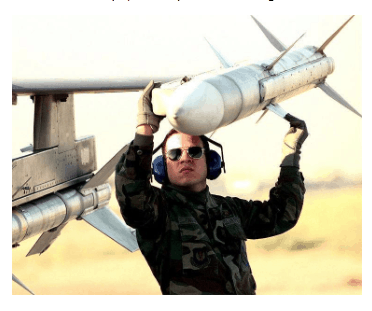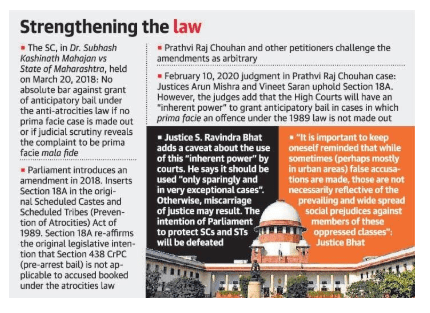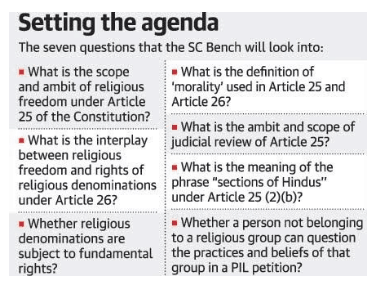IASbaba's Daily Current Affairs Analysis

IAS UPSC Prelims and Mains Exam – 11th February 2020
Archives
(PRELIMS + MAINS FOCUS)
SuperCam
In news:
- NASA is sending a new laser-toting robot as one of seven instruments aboard the Mars 2020 rover Called SuperCam
- It fires lasers to study rocks, and will look for signs of past life on Red Planet.
- The robot is used for studying mineralogy and chemistry, It might help scientists find signs of fossilised microbial life on Mars.
- SuperCam includes a microphone so scientists can listen each time the laser hits a target.
Supreme Court upholds changes to SC/ST atrocities law
In news:
- Supreme Court upheld a 2018 amendment which barred persons accused of committing atrocities against those belonging to the Scheduled Castes and the Scheduled Tribes from getting anticipatory bail.

Daily Current Affairs IAS | UPSC Prelims and Mains Exam – 11th February 2020
From Prelims point of view:
Various forms of atrocities against SC/ST
Caste clashes: Tensions caused between upper castes and Dalits due to the perceived upward mobility of Dalits.
Cow Vigilantism: Dalits and Muslims are at the receiving end of this vigilantism.
Honour Killing: extreme form of Moral Policing. (Fear of losing the caste status which brings them several benefits, people often commit this heinous crime when their son or daughter marry someone from outside their caste)
Social boycott: Khap panchayat/caste panchayat ostracizing Dalits them from society.(Law Commission drafted the Prohibition of Unlawful Assembly (Interference with the Freedom of Matrimonial Alliances) Bill, 2011 that sought to declare khap panchayats unlawful).
Manual scavenging: Manual scavenging is linked to a caste system where the so-called low castes were expected to perform this job.
Constitutional provisions against SC/ST atrocities:
Article 17 of the constitution prohibits the practice of untouchability.
Article 46 promotes the educational and economic interests of SCs, STs, and other weaker sections of the society and protects them from social injustice and exploitation.
Article 338 – National Commission for Scheduled Castes
- Investigate and monitor all matters relating to the constitutional and other legal safeguards for the SCs and to evaluate their working.
- Inquire into specific complaints with respect to the deprivation of rights and safeguards of the SCs.
338-A – National Commission for Scheduled Tribes
*Mains perspective will be covered in Mains section
Review court can refer questions to larger Bench
In news:
- A nine-judge Constitution Bench of the Supreme Court upheld the decision of the five-judge Sabarimala Review Bench
- To refer to a larger Bench questions on the ambit and scope of religious freedom practised by multiple faiths across the country.
- Bench framed seven questions of law which it would decide now.
From prelims point of view:

Daily Current Affairs IAS | UPSC Prelims and Mains Exam – 11th February 2020
Article 25 :
- The Article 25 states that every individual is “equally entitled to freedom of conscience” and has the right “to profess, practice and propagate religion” of one’s choice.
- Practicing religion or the act of propagating it should not, however, affect the “public order, morality and health.”
- The Article doesn’t put any restriction on the government when it comes to making any law to regulate “economic, financial, political or other secular” activities, which may be associated with religious practice.
- According to Article 25, the gates of Hindu religious institutions should be opened to every section of Hindus.
- Here the term ‘Hindus’ also includes individuals who profess Sikh, Jain or Buddhist religion. The same holds true for the term ‘Hindu religious institutions.
U.S. nod for air defence system sale to India
In news:
- U.S. Department of State has approved the potential sale of a $1.867 billion Integrated Air Defence Weapon System (IADWS) to India.
- The Integrated Air Defence Weapon System, also known as the National Advanced Surface to Air Missile System (NASAMS), provides integrated air missile defence
- The IADWS system includes radar, launchers, targeting, and guidance systems, advanced medium-range air-to-air missile (AMRAAM) and Stinger missiles, and related equipment and support
AMRAAM
- The AIM-120 Advanced Medium-Range Air-to-Air Missile (AMRAAM)
- It is an American beyond-visual-range air-to-air missile (BVRAAM) capable of all-weather day-and-night operations fire-and-forget weapon
- AMRAAM is the world’s most popular beyond-visual-range missile

Daily Current Affairs IAS | UPSC Prelims and Mains Exam – 11th February 2020
SRC: Click here
National Advanced Surface-to-Air Missile System was developed by USA in partnership with Norway. NASAMS-II is an upgraded version of NASAMS of Norway called Norwegian Advanced Surface to Air Missile System.
(MAINS FOCUS)
Indian Polity & Governance
Topic: General Studies 2:
- Government policies and interventions for development in various sectors and issues arising out of their design and implementation.
Reservations in Promotions
A two judge Supreme Court judgment stated that
- Individuals do not have fundamental right to claim reservation in promotions.
- States are not legally bound to provide reservations in promotions. If it intends to do so then it has to justify it through quantifiable data about the inadequacy of their representation in public services.
- Courts could not issue a mandamus directing the States to provide reservation in promotion.
It shows that affirmative action programmes allowed in the Constitution flow from “enabling provisions” and are not rights as such.
What was the background of the judgement?
- Uttarakhand High court order directing data collection on the adequacy or inadequacy of representation of SC/ST candidates in the State’s services.
- However, Supreme Court struck the order on the grounds that once there is decision not to extend reservation in promotion, then question of such data is not relevant
Constitutional Provisions with regard to reservations
- Article 16(4) – Empowers State to provide reservation for any backward classes of citizens
- Article 16(4a) – introduced in 1995 by 77th Constitutional Amendment Act – Empowers State to provide reservation in promotion in favour of SC and ST.
Both the above provisions empower the State from making reservations if, “in the opinion of the State”, these groups are “not adequately represented”
Previous Judgements on this matter
In its landmark 1992 decision in Indra Sawhney vs Union of India, the Supreme Court had held that reservations under Article 16(4) could only be provided at the time of entry into government service but not in matters of promotion.
On June 17, 1995, Parliament, acting in its constituent capacity, adopted the 77th Constitutional amendment by which clause (4A) was inserted into Article 16 to enable reservation to be made in promotion for SCs and STs.
The Supreme Court in M. Nagaraj v. Union Of India 2006 case while upholding the constitutional validity of Art 16(4A) held that it is an enabling provision i.e. State is not bound to make such reservations in promotions. However, if it seeks to do so then it must collect quantifiable data on three parameters —
- The backwardness of the class
- The inadequacy of the representation of that class in public employment;
- The general efficiency of service would not be affected
In Jarnail Singh vs Lachhmi Narain Gupta case of 2018, the Supreme Court held that reservation in promotions does not require the state to collect quantifiable data on the backwardness of the Scheduled Castes and the Scheduled Tribes.
The court upheld the argument that once various caste groups were listed as SC/ST, this automatically implied they were backward.
Issues with the present judgement
- Not in the spirit of affirmative action: The government does not have to show any kind of justification in deciding not to implement reservation in promotion.
- This is an opaque form of functioning and appears to be going by the letter of the law, not its spirit of providing affirmative action.
- Also, since a 5-judge bench of the Supreme Court has already upheld reservation in promotions, it is not clear whether a two-judge bench can make an interpretation that is in variance with this
- It means that government is not obligated to come with affirmative action (in promotions) if the social situation that keeps some sections backward persists
Conclusion
- Reservation is no more seen by the Supreme Court as an exception to the equality rule; rather, it is a facet of equality.
- However, earlier judgments gave an impression that reservations were an entitlement for weaker sections of society but that it should be viewed only as an enabling provision.
- States should come up quantifiable data to monitor if reservation policies is indeed benefitting the discriminated section of society and if not then make necessary policies.
Connecting the dots!
- Creamy layer in SC/ST
- Reservation for localities- legislation brought by AP, Maharashtra
Science & Tech
Topic: General Studies 3:
- Science and Technology- developments and their applications and effects in everyday life.
Genome India Project
The Genome India Project, is a collaboration of 20 institutions including the Indian Institute of Science and some IITs, whereby in the first phase the genomic data of 10,000 Indians will be catalogued
By sequencing the genome, researchers can discover the functions of genes and identify which of them are critical for life.
What is Genome?
- Every organism’s genetic code is contained in its Deoxyribose Nucleic Acid (DNA), the building blocks of life.
- A genome is defined as an organism’s complete set of DNA, including all of its genes. It contains all of the information needed to build and maintain that organism.
- In humans, a copy of the entire genome — more than 3 billion DNA base pairs — is contained in all cells that have a nucleus.
The Human Genome Project (HGP) – from 1990 to 2003 – was an international programme that led to the decoding of the entire human genome. India was also a collaborator for this programme
What is need for Genome India project if HGP has mapped human genome?
- 95% of the genome samples available use the white, Caucasian genome as the base. Most genomes have been sourced from urban middle-class persons and are not really seen as representative and useful for India specific needs.
- India’s project aim is to ultimately build a grid of the Indian reference genome, to understand fully the type and nature of diseases and traits that comprise the diverse Indian population
- For example, if the Northeast sees a tendency towards a specific disease, interventions can be made in the region, assisting public health, which make it easier to battle the illness.
Benefits/Significance of Indian Project
- Personalised Medicine: Propensities to disease can be mapped to variations across genomes and as a result public health interventions can be targeted better, and diseases anticipated before they develop
- Deeper Understanding of Ecology: Traversing from the world’s tallest mountain range to warm seas through multiple bio-zones, this project could provide much information on the interplay of species and genetic groups within them
- International Cooperation: The Indian project will aim to vastly add to the available information on the human species and advance the cause, both because of the scale of the Indian population and the diversity here.
Challenges to the Genome India Project
- Medical Ethics: The project aims only to create a database of genetic information and gene modification is not a stated objective. However, the presence of such wide knowledge enhances the risk of doctors privately performing gene modification.
- Data & Storage: After collection of the sample, the anonymity of the data and questions of its possible use and misuse needs to be addressed especially since India has not passed the data privacy bill
- Fear of Scientific Racism: scientific studies of genes and classifying them could reinforce racial/caste stereotypes and allow for politics and history to acquire a racial twist.
- Political Misuse: In India a lot of politics is now on the lines of who are “indigenous” people and who are not. A Genome India Project could add a genetic dimension to the cauldron.
Way Ahead
Genome India Project provides an opportunity for India to make progress in the fields of biotechnology and healthcare. Thus, it needs to be carried with necessary safeguards about data & ethical issues.
Did you know?
- Shenzen-based scientist helped create the world’s first gene-edited babies.
- He Jiankui stunned the world when he announced in 2018 that twin girls had been born with modified DNA to make them HIV-resistant
Connecting the dots!
- Agriculture and Genetic engineering
- Biotechnology and issue of equity.
(TEST YOUR KNOWLEDGE)
Model questions: (You can now post your answers in comment section)
Note:
- Correct answers of today’s questions will be provided in next day’s DNA section. Kindly refer to it and update your answers.
- Comments Up-voted by IASbaba are also the “correct answers”.
Q.1) what is ‘SuperCam’, recently in the news?
- Electric plane tested by NASA
- new laser-toting robot the Mars 2020 rover by NASA
- Space observatory launched by China
- Reusable rocket designed by ISRO
Q.2 NASA’s Deep Impact space mission was employed to take detailed pictures of which comet nucleus?
- Halley’s Comet
- Hale-Bopp
- Hyakutake
- Tempel 1
Q.3. Right to Privacy is protected as an intrinsic part of Right to Life and Personal Liberty. Which of the following in the Constitution of India correctly and appropriately imply the above statement?
- Article 14 and the provisions under the 42nd Amendment to the Constitution
- Article 17 and the Directive Principles of State Policy in Part IV
- Article 21 and the freedoms guaranteed in Part III
- Article 24 and the provisions under the 44th Amendment to the Constitution
ANSWERS FOR 10 FEB 2020 TEST YOUR KNOWLEDGE (TYK)
| 1 | C |
| 2 | B |
| 3 | A |
Must Read
About Preventive detention:
About Coronavirus :
About agriculture vs Industry:














